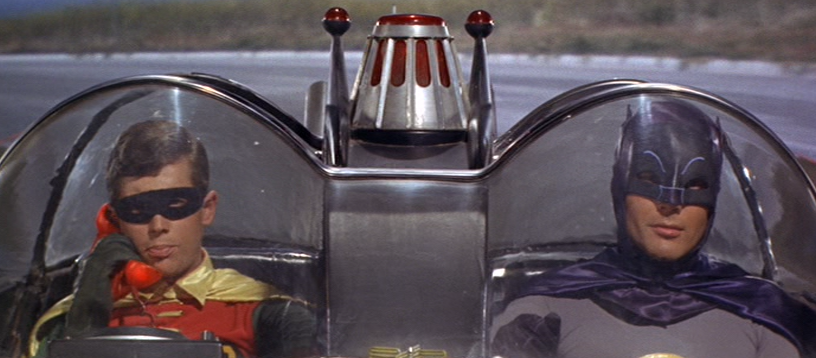
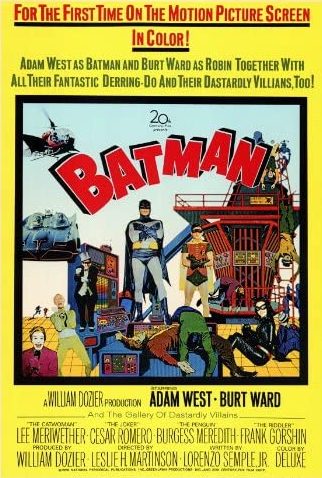
“What weighs six ounces, sits in a tree, and is very dangerous?”
“A sparrow with a machine gun.”
Batman: The Movie is perfect for those who find the idea of a millionaire playboy dressing up in a batsuit and fighting criminals just a little bit silly. There’s only a small portion of that crowd who would want to sit down and watch an hour and forty-five minutes of pure camp on a regular basis, which is why the film is most fondly remembered by people who watched it as kids. And that’s exactly who it was made for.
Like Superman and the Mole Men, Batman was made to help launch a children’s television series. The Caped Crusader is portrayed by Adam West, who became a legend of nerdom as a result of his role in the film and series, allowing him to make a slew of cameo appearances later in his life in sitcoms and animated television shows. Burt Ward plays Batman’s “perfectly ordinary American” sidekick Robin, and there are four—yes, four—main villains. Burgess Meredith portrays the Penguin; Cesar Romero the Joker; Frank Gorshin the Riddler; and Lee Merriweather plays Catwoman and a Soviet journalist named Kitayna Ireyna Tatanya Kerenska Alisoff.
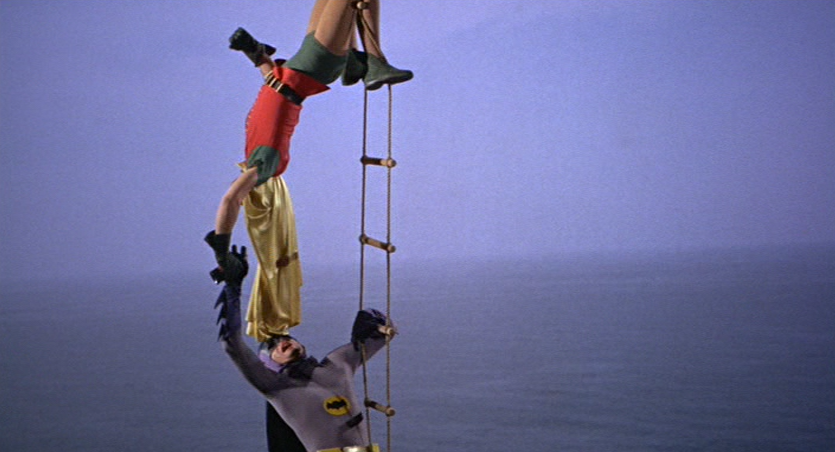
The film itself is such an odd historical object—it is at once both devoid of nearly all cinematic merit and also a watershed moment in the history of Batman and superhero films in general. When viewed through the lens of Tim Burton and Christopher Nolan’s takes on the character, one could understandably scoff at this first feature length film for the character due to its bonkers script, low budget sets and costume design, and generally gimcrack presentation. But to act all pompous and say that camp has no place in a Batman adaptation simply because The Dark Knight Returns has ushered in a semi-permanent era of conflicted, brutal, “realistic” versions of Batman ignores a large portion of the character’s history. Part of what makes Batman so compelling is that he is so versatile. He’s gone through the hands of countless authors, he’s been in various animated shows, he is the star of his own Lego movie, and he’s been parodied as much as any iconic character. He’s not only the brooding kicker of rear ends that the last few decades of big budget movies have made him out to be, and this tongue-in-cheek outing is proof that zany slapstick is a legitimate and potentially crucial element in the composite mythology of Batman.
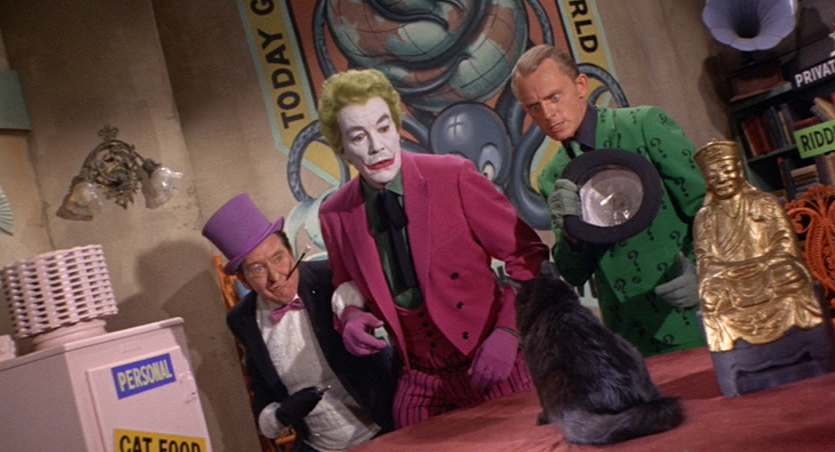
The script is simply insane. It begins with Batman and Robin tracking down a yacht in the Batcopter only to discover that the yacht was a holographic projection emanating from a projector buoy. As Batman is lowered down to the top deck of the yacht—on a labeled Bat-ladder, no less—the yacht disappears and a shark latches onto his leg. He pummels it with a closed fist, but is only able to ward off the aquatic beast when Robin climbs down the ladder and hands him a can of shark repellent spray while dangling upside down by his legs. The bizarre scene sets the tone for the rest of the film. Aesthetically, the 1966 Batman is the visual equivalent of eating pure sugar. The costume designs are outrageous, the props are excessively flamboyant, “kapow” and “wham” are stenciled onto the screen in bright colors, every item in the Batcave is labeled—things like “Film Developing Tank (Super Fine Batgrain), Magnifying Glass, Inter-Dig-Ital Batsorter—you get the idea. It’s decidedly unreal; a childish dream world where the United States government sells war-surplus submarines to men named “P. N. Guin” and does not require them to leave an address, people can be turned into a dry powder and brought back to life by adding water, and this gem of a conversation was left to stand in the editing room:
Gordon: Could be any one of them, but which one? W—which ones?
Batman: Pretty fishy what happened to me on that ladder.
Gordon: You mean, where there’s a fish, there could be a Penguin.
Robin: But wait! It happened at sea! See? “C” for Catwoman!
Batman: Yet… an exploding shark was pulling my leg!
Gordon: The Joker!
O’Hara: All adds up to a sinister riddle. Riddle-er. Riddler?
Gordon: Oh, a thought strikes me. So dreadful I scarcely dare give it utterance.
Batman: The four of them. Their forces combined…
Robin: Holy nightmare!
Gordon: Penguin, Joker, Riddler… and Catwoman, too! The sum of the angles of that rectangle is too monstrous to contemplate.
Batman: We’ve been given the plainest warning. They’re working together to take over…
O’Hara: Take over what, Batman? Gotham City?
Batman: Any two of them would try that!
Commissioner Gordon: The whole country?
Batman: If it were three of them, I would say yes, but four? Their minimum objective must be… the entire world.
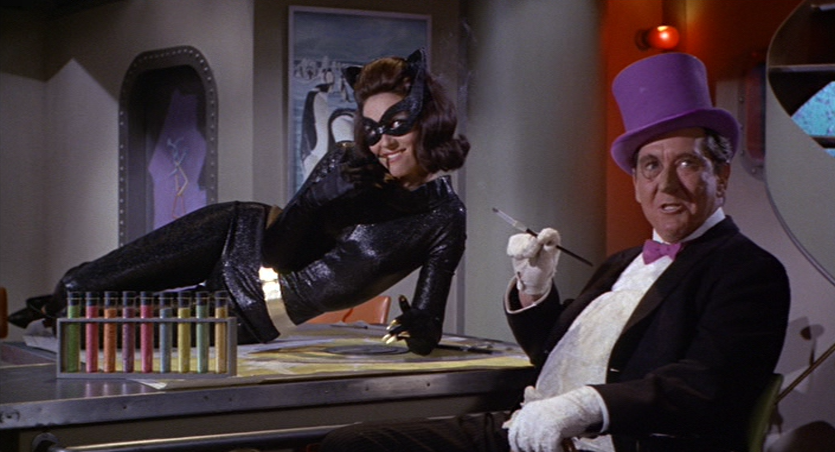
The cast seems to have a blast hamming it up, slinging cheesy lines all over the place and playing up their characters’ mannerisms. Meredith and Gorshin steal most of the spotlight as the Penguin and the Riddler. Meredith chews scenery like his life depends on it, and he is able to make his “wa wa wa” noises with a cigarette sticking out of the corner of his mouth. Gorshin jumps between cold calculation and mania with ease and some would argue his portrayal of the Riddler has served as an inspiration for modern versions of the Joker. Certainly his performance has more in common with the modern Joker than Romero’s Joker does. Merriweather’s dual role is fun—she gets to freak out pirate henchmen with her catlike antics and use an absurd Russian action when she is in the guise of Miss Kitka.
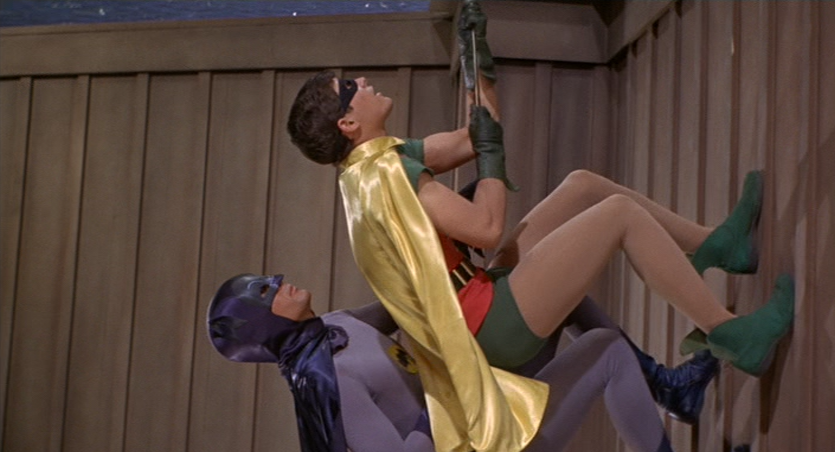
The villains purchase a war-surplus submarine, steal a dehydrator gun, and kidnap Bruce Wayne in order to lure Batman to the rescue. This doesn’t work, of course, because they don’t know that Bruce Wayne is Batman. Posing as the journalist Kitka, Catwoman seduces Bruce, who pursues her with hot blooded intensity from the time he sets eyes on her. His lines are full of innuendo and he asks himself into her apartment. Since it has to be weird, he quotes Edgar Allan Poe to her. “And all my days are trances, and all my nightly dreams are where thy dark eye glances and where they footstep gleams.” Just as Bruce finds himself about to be “utterly and madly carried away” by the alluring Miss Kitka, the other three villains and some henchmen break into her apartment and engage in some fisticuffs with our hero, eventually bringing him down in a ten man dogpile.
Adam West delivers his lines with just the right amount of self-awareness. He knows how silly his lines and actions are, and refrains from phoning them in or taking them too seriously. At one point, he finds himself with a bomb in his arms, unable to find a suitable place to dispose of it, running into nuns, mothers with baby carriages, young lovers in a boat, etc. at every turn. “Some days you just can’t get rid of a bomb,” he says, capping off a scene that was given an extended homage in Christopher Nolan’s The Dark Knight Rises. West carries himself as a man without moral conflict; he is a model citizen and his words carry weight, setting him apart from the boisterous cast of villains. Despite his moral hang ups that keep him from using guns and or killing his foes, whenever he believes that the Joker, the Riddler, and the Penguin have harmed Miss Kitka, he informs them that he will rend them limb from limb, and sounds like he has reasoned it out and decided that such a punishment is a just one.
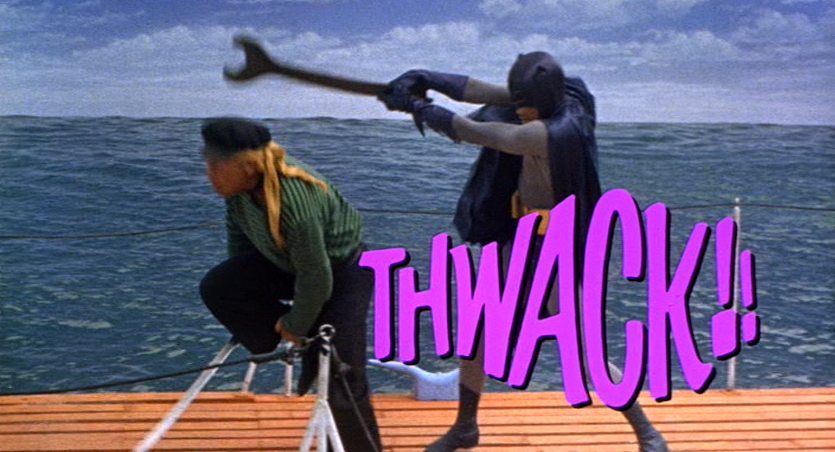
Eventually, Batman foils the villains’ plan to kidnap the United World Security Council using the dehydrator gun. It’s a bit underwhelming, and features an extended fight scene with many instances of “pow” and “zwapp” and “sploosh” occupying the screen while Nelson Riddle’s surprisingly memorable score plays loudly. At one point, Batman spends a few moments carrying Catwoman’s pet cat before gently tossing it onto a liferaft. It’s completely goofy, campy, and fun.
It’s hard to say exactly how prominent this film deserves to be in the annals of Batman lore. By today’s standards, it’s sloppy, low-budget, and kitsch. But by historical standards, it fits right in with the comics of its day, both visually and tonally. While it’s common for it to be seen as campy, it’s not as common to understand that it was intentionally so, as it was made as a satirization of the 1940s black-and-white Batman serials. It knows that it is silly, it follows through on that M.O. and has fun doing it. Too many superhero movies find themselves plagued by a desire to be taken seriously while also maintaining that camp vibe. A good many superhero films have now succeeded at delivering a serious version of their characters, but melding a serious tone with campy elements is an incredibly tough task that only a handful of them have successfully pulled off. Those films are fine and I enjoy them, but I’d rather watch intentional camp than the many failed attempts at a hybrid any day of the week.
I am extremely impressed with your writing abilities and with the structure of your weblog. Did you customize it yourself? Either way keep up the nice quality writing, it’s rare to see a great blog like this one today.